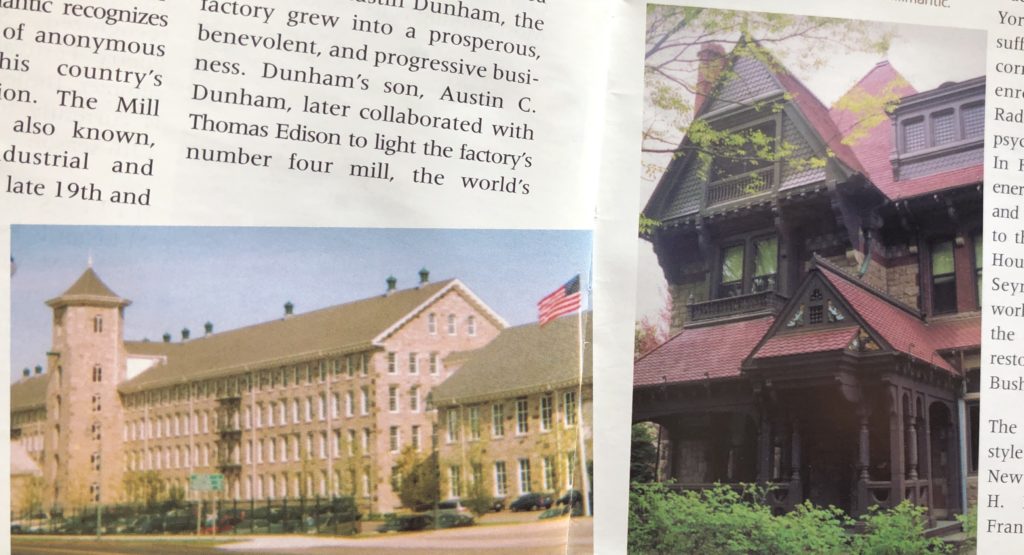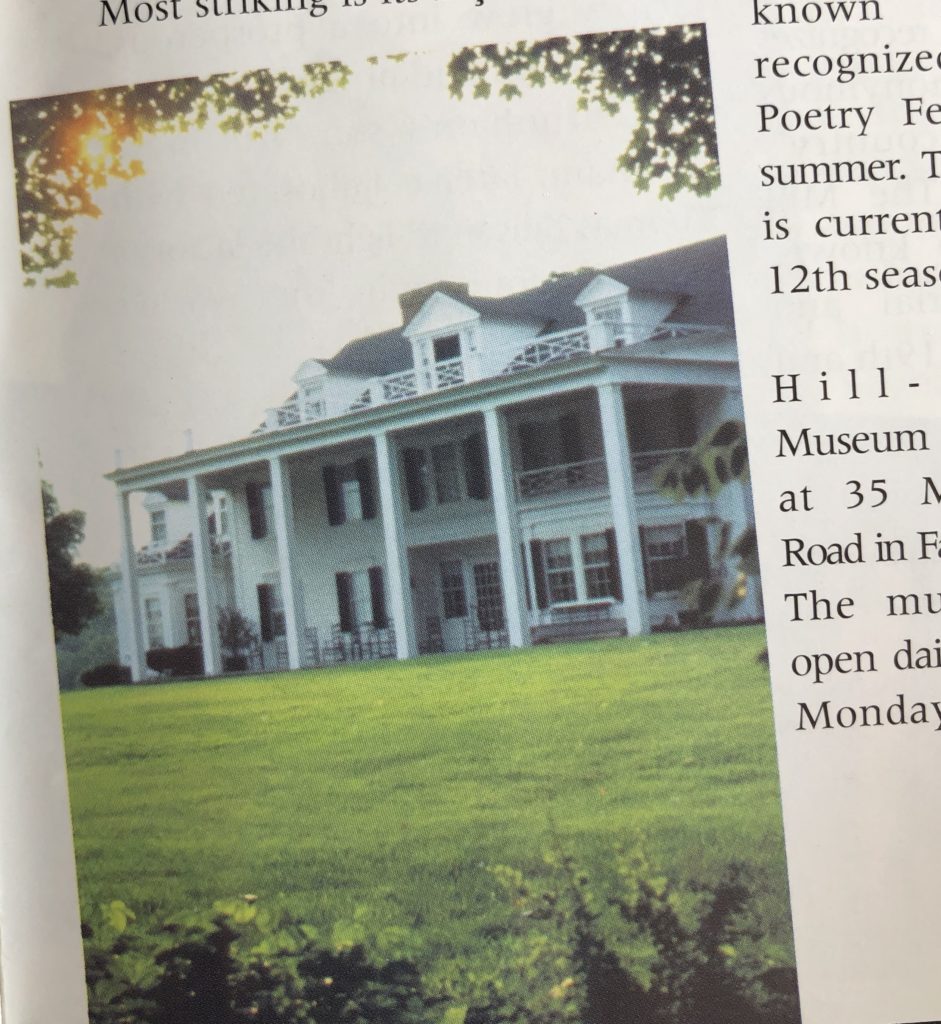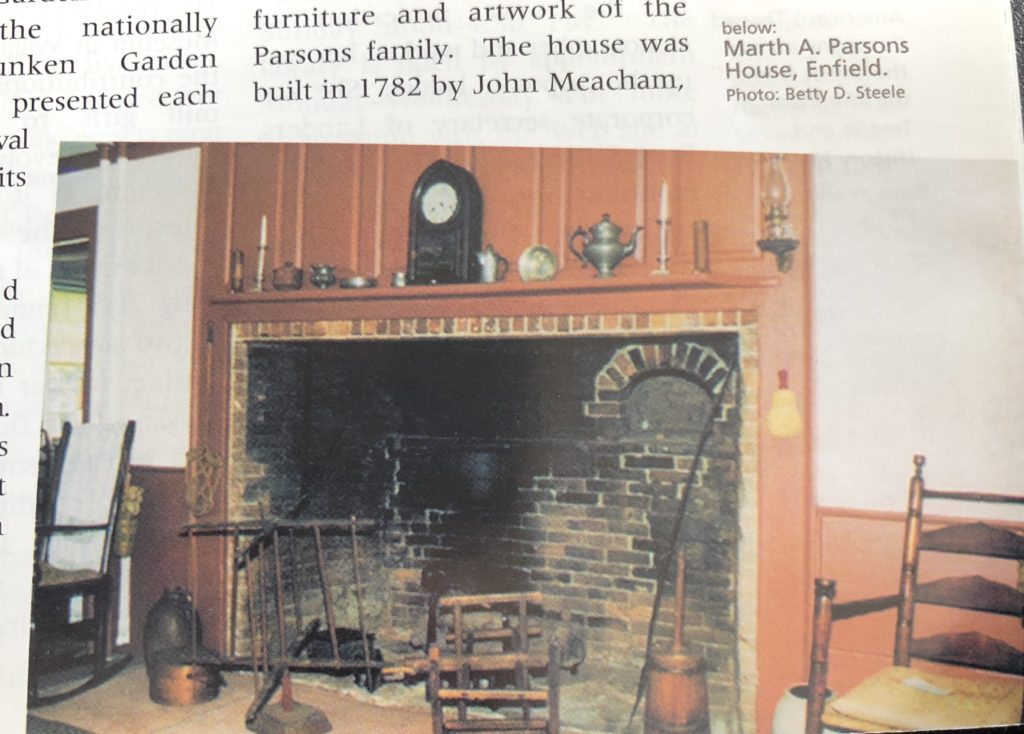 (c) Connecticut Explored Inc. Summer 2003
(c) Connecticut Explored Inc. Summer 2003
Subscribe/Buy the Issue!
Hill-Stead Museum
By Melanie Anderson Bourbeau
In the late 1890s architect Theodate Pope Riddle embarked upon her most ambitious project to date — the creation of a retirement home for her parents, Alfred and Ada Pope, to showcase their magnificent collection of Impressionist paintings. Riddle’s intention was to create a new home with all the modern conveniences, yet have it mimic farmsteads of the 1700s and look as if it had been in situ for generations. While the interior of the home was fully outfitted for entertaining and the complete comfort of guests, its exterior was meant to signal our nation’s history, particularly colonial New England.
Hill-Stead was completed in 1901, and today is recognized as one of the premier examples of Colonial Revival architecture. Most striking is its façade, modeled after George Washington’s Mount Vernon. The Impressionist collection includes works by Mary Cassatt, Edgar Degas, and Claude Monet. The Popes also collected prints, sculptures, and porcelains. The artwork and furnishings remain just as they were when the family was in residence, providing visitors with a glimpse into the lives of a Gilded Age industrialist and his socialite wife and, later, Riddle and her career-diplomat husband. In addition to designing the house and creating an extensive dairy compound on the property, Riddle oversaw the shaping of the landscape, complete with roadways, tree-lined paths, stone walls, meadows, and orchards.
Another prominent feature is the Sunken Garden, which was redesigned circa 1920 with a planting plan by Beatrix Jones Farrand, the noted American landscape designer. These days the Sunken Garden is best known for the nationally recognized Sunken Garden Poetry Festival, presented each summer. The festival is currently in its 12th season.
Hill-Stead Museum is located at 35 Mountain Road in Farmington. The museum is open daily, except Mondays, from 10:00 AM to 5:00 PM, and the grounds are open daily from dawn to dusk. For more information, call 860-677-4787 or visit the website at www.hillstead.org.
Melanie Anderson Bourbeau is a curator at Hill-Stead Museum.
Explore!
Read more about Hill-Stead Museum HERE.
The Martha A. Parsons House Museum
By Elizabeth J. Normen
In 1912, at the young age of 43, Martha A. Parsons (1869 – 1962) of Enfield achieved a rare thing for a woman of her era. She was promoted to a position as a corporate officer of a Connecticut manufacturing firm. The home of this early 20th-century career woman is open to the public as the Martha A. Parsons House Museum. Located in Enfield’s historic district, the house is a fine example of early American architecture and contains the furniture and artwork of the Parsons family.
The house was built in 1728 by John Meacham, brother of Joseph Meacham who helped found Enfield’s Shaker Community ten years later. Parson’s ancestor, sea captain John Ingraham, bought the house in 1800 when he retired. In addition to a small collection of Enfield Shaker furniture, some of the most remarkable objects on view are the original late 18th-century George Washington memorial wallpaper in the front hall, two cherry Hepplewhite tables brought from the West Indies by Captain Ingraham as a wedding gift to his daughter, and a delicate Enfield-made candle-stand with drawer that was included in the Wadsworth Atheneum’s 1985 Great River exhibition.
Parsons was born in 1869 to a prominent Enfield family and earned the equivalent of a teaching certificate from Enfield High School. She was one of the first to learn the newly devised Gregg shorthand. Armed with this innovative skill, she joined the Morgan Envelope Company in the 1890s in the new profession of stenographer and worked her way up the corporate ladder. She was corporate secretary of Landers, Frary, & Clark, a New Britain-based manufacturer of household appliances, from 1912 until her retirement at age 50 in 1919.
After she retired from corporate life, Parsons returned to the family home in Enfield to live with her two sisters Juliaette and Mary, both of whom were also professionals (one a nurse and the other a teacher) and, like Martha, had never married. The three sisters were involved in civic and church matters and stayed abreast of current affairs throughout their lives, donating the large sum of $1,600 during World War I to the American Field Service of France for an ambulance. Upon her death in 1962, Martha bequeathed her home and its contents to the people of Enfield.
The Martha A. Parsons House Museum is located at 1387 Enfield Street (Route 5) in Enfield, Connecticut. It is open Sundays from 2 to 4:30 PM from May to October. Admission is free. More information is available on the Enfield Historical Society website.
Explore!
Read another story about Enfield HERE.
The Windham Textile and History Museum
By Beverly York
The Windham Textile and History Museum in Willimantic recognizes the contributions of anonymous mill girls to this country’s industrial revolution. The Mill Museum, as it is also known, interprets the industrial and social aspects of the late 19th and early 20th centuries in two architecturally distinct former mill buildings. The Dugan Mill exhibit recreates working conditions and visitors learn about the men, women, and children who ran the cards, spinning machines, dyes house, printing labels, and repackaging thread. The reproduced mill floor contains some of the machines and other equipment that produced 90,000 miles of thread per day during the factory’ heyday in the 1890s.
Dunham Hall, once the company store and library, now displays a recreated immigrant mill house. Such a mill house was home to Irish immigrants in 1860s, French Canadians in the 1890s, and Eastern Europeans in the 1920s. In contrast, the Museum also interprets a few rooms from the manager’s mansion, furnished in decorative Queen Anne, Second Empire, and other Victorian styles. The Museum contains the unique Dunham Hall library built as an educational benefit to the workers.
Originally founded as the Willimantic Thread Company in the 1850s by Hartford-area industrialist Austin Dunham, the factory grew into a prosperous, benevolent, and progressive business. Dunham’s son, Austin C. Dunham later collaborated with Thomas Edison to light the factory’s number four mill, the world’s first factory built for electrical illumination. The British-owned American Thread Company eventually purchased the factory, which was Connecticut’s largest employer a century ago. The rich, industrial heritage of the American Thread Company lives on in the magnificent granite architecture visible from Main Street and in the voices of the immigrant workers who toiled to produce thread that clothed the world.
The Windham Textile and History Museum is located in Willimantic at the corner of Main and Union streets. It is open Wednesday to Sunday 1:00-4:00 PM from Memorial Day to Columbus Day and Friday to Sunday 1:00-4:00 PM the rest of the year. Also by appointment. For more information call 860-456-2178 or visit the website at www.millmuseum.org.
Beverly York is the curator of the Windham Textile and History Museum, Willimantic.
Explore!
Listen to a podcast about the Windham Textile Museum HERE.
Read more about Windham HERE.

(l) Former Willimantic (later American) Thread Company across the street from the Windham Textile and History Museum; (r) Katharine Seymour Day House of the Harriet Beecher Stowe Center, Hartford. photo: Nancy O. Albert
The Katharine Seymour Day House
By Dawn C. Adlietta
Standing on the corner of Farmington Avenue and Forest Street, between the homes of Harriet Beecher Stowe and Mark Twain, is the Katharine Seymour Day House, another Hartford architectural gem. The house is named to honor Katharine Seymour Day (1870-1964), founder of the Harriet Beecher Stowe Center. Day was a grandniece of Harriet Beecher Stowe and a granddaughter of suffragist Isabella Beecher Hooker. She never lived in the house that bears her name but purchased it to save it from being destroyed.
Like her famous ancestors, Katharine Seymour Day did not shy away from controversy. She studied modern art in Paris and New York, marched for women’s suffrage, and fought political corruption. At age 47, she enrolled as a freshman at Radcliffe, receiving an M.A. in psychology within five years. In Hartford, Day focused her energies on historic preservation and urban planning. In addition to the Harriet Beecher Stowe House and the Katharine Seymour Day House, she worked with others to protect the Mark Twain House and to restore the Corning Fountain in Bushnell Park.
The c. 1884 Queen Anne-style house was designed by New York architect Francis H. Kimball for attorney Franklin Chamberlin. The original exterior paint scheme, roof shingles, crestings, and finials have been recently restored. The interior of the 20-room house contains ornately carved cherry and oak paneling with Gothic inspired images and floral designs, fireplace tiles from the Low Tile Works Company, stained glass windows, and two interior balconies, one of which overlooks a multi-storied conservatory. Today, the building houses the Stowe Center Research Library and administration offices. The first floor is used for Center events and is included in most tours of the House. The library is open by appointment.
In the tradition of her family Katharine Seymour Day made a lasting difference to the cultural legacy of Hartford. Today, the Stowe Center honors that legacy and uses the work of Harriet Beecher Stowe to inspire others to make a positive difference in their own communities. Summer hours are Monday-Saturday, 9:30 AM-4:30 PM; Sunday noon-4:30 PM. The library is open by appointment Monday-Wednesday. For more information visit the website at www.HarrietBeecherStowe.org or call 860-522-9258.
Dawn C. Adlietta is a curator at the Harriet Beecher Stowe Center.
Explore!
Read more stories about the Harriet Beecher Stowe Center HERE.


